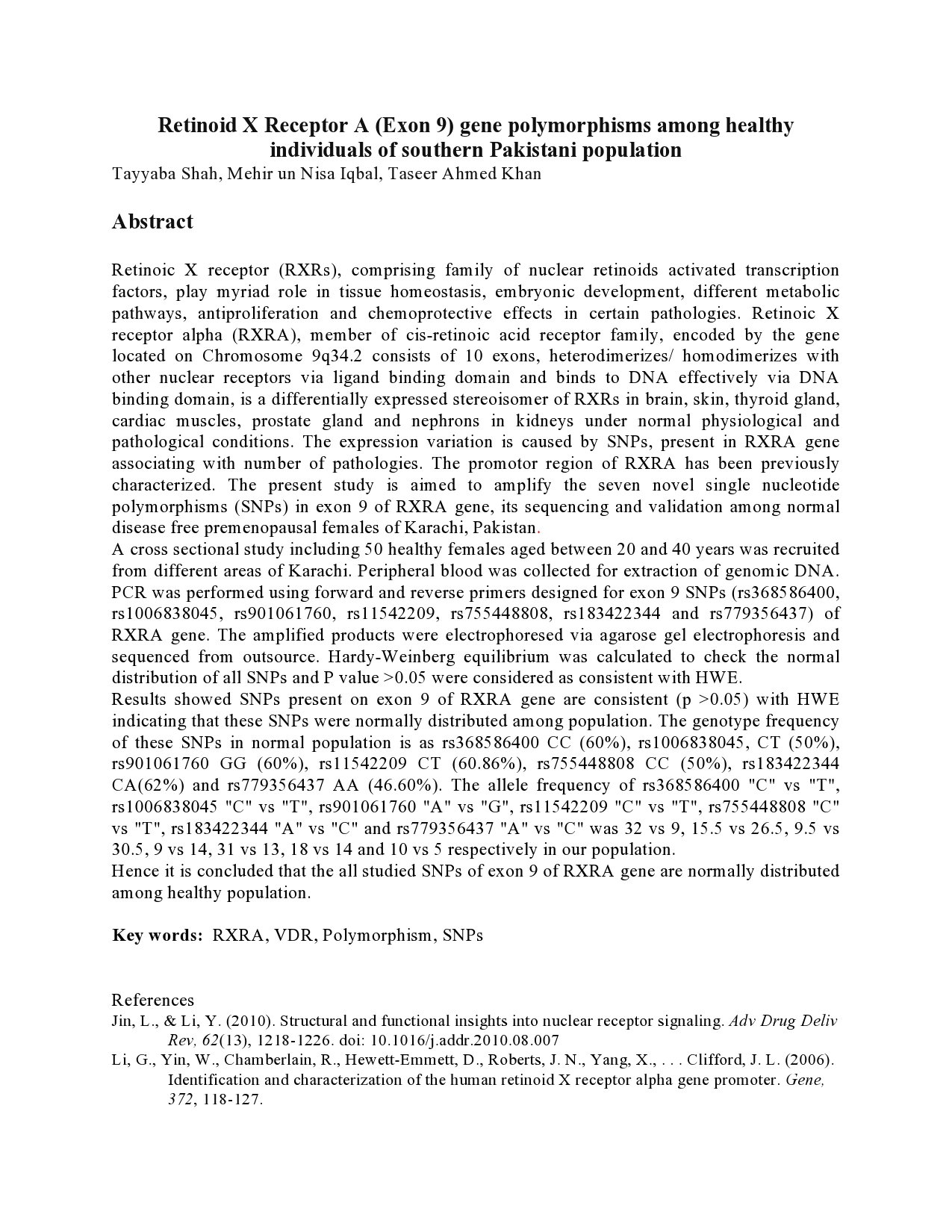Retinoic X receptor (RXRs), comprising family of nuclear retinoids activated transcription factors, play myriad role in tissue homeostasis, embryonic development, different metabolic pathways, antiproliferation and chemoprotective effects in certain pathologies. Retinoic X receptor alpha (RXRA), member of cis-retinoic acid receptor family, encoded by the gene located on Chromosome 9q34.2 consists of 10 exons, heterodimerizes/ homodimerizes with other nuclear receptors via ligand binding domain and binds to DNA effectively via DNA binding domain, is a differentially expressed stereoisomer of RXRs in brain, skin, thyroid gland, cardiac muscles, prostate gland and nephrons in kidneys under normal physiological and pathological conditions. The expression variation is caused by SNPs, present in RXRA gene associating with number of pathologies. The promotor region of RXRA has been previously characterized. The present study is aimed to amplify the seven novel single nucleotide polymorphisms (SNPs) in exon 9 of RXRA gene, its sequencing and validation among normal disease free premenopausal females of Karachi, Pakistan. A cross sectional study including 50 healthy females aged between 20 and 40 years was recruited from different areas of Karachi. Peripheral blood was collected for extraction of genomic DNA. PCR was performed using forward and reverse primers designed for exon 9 SNPs (rs368586400, rs1006838045, rs901061760, rs11542209, rs755448808, rs183422344 and rs779356437) of RXRA gene. The amplified products were electrophoresed via agarose gel electrophoresis and sequenced from outsource. Hardy-Weinberg equilibrium was calculated to check the normal distribution of all SNPs and P value >0.05 were considered as consistent with HWE. Results showed SNPs present on exon 9 of RXRA gene are consistent (p >0.05) with HWE indicating that these SNPs were normally distributed among population. The genotype frequency of these SNPs in normal population is as rs368586400 CC (60%), rs1006838045, CT (50%), rs901061760 GG (60%), rs11542209 CT (60.86%), rs755448808 CC (50%), rs183422344 CA(62%) and rs779356437 AA (46.60%). The allele frequency of rs368586400 “C” vs “T”, rs1006838045 “C” vs “T”, rs901061760 “A” vs “G”, rs11542209 “C” vs “T”, rs755448808 “C” vs “T”, rs183422344 “A” vs “C” and rs779356437 “A” vs “C” was 32 vs 9, 15.5 vs 26.5, 9.5 vs 30.5, 9 vs 14, 31 vs 13, 18 vs 14 and 10 vs 5 respectively in our population. Hence it is concluded that the all studied SNPs of exon 9 of RXRA gene are normally distributed among healthy population. Key words: RXRA, VDR, Polymorphism, SNPs References Jin, L., & Li, Y. (2010). Structural and functional insights into nuclear receptor signaling. Adv Drug Deliv Rev, 62(13), 1218-1226. doi: 10.1016/j.addr.2010.08.007 Li, G., Yin, W., Chamberlain, R., Hewett-Emmett, D., Roberts, J. N., Yang, X., . . . Clifford, J. L. (2006). Identification and characterization of the human retinoid X receptor alpha gene promoter. Gene, 372, 118-127. Wu, J., & Jiang, R. (2013). Prediction of deleterious nonsynonymous single-nucleotide polymorphism for human diseases. The Scientific World Journal, 2013.
Physiology 2021 (2021) Proc Physiol Soc 48, PC064
Poster Communications: Retinoid X Receptor A (Exon 9) gene polymorphisms among healthy individuals of southern Pakistani population
Tayyaba Shah1, Mehir un Nisa Iqbal1, Taseer Ahmed Khan1
1 Department of Physiology, University of Karachi, Karachi, Pakistan
View other abstracts by:
Where applicable, experiments conform with Society ethical requirements.

